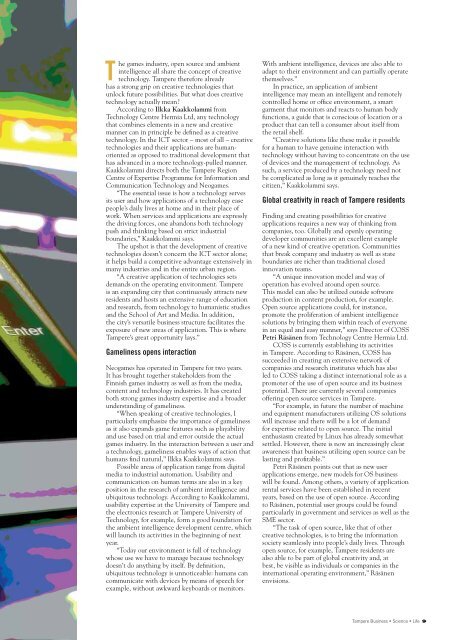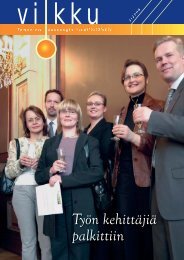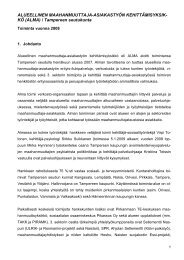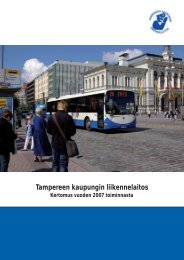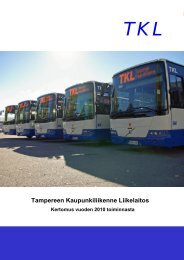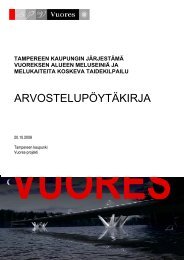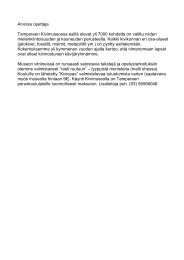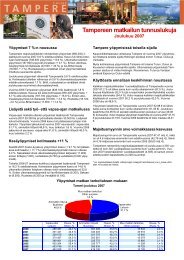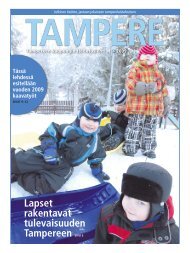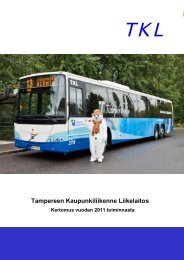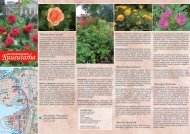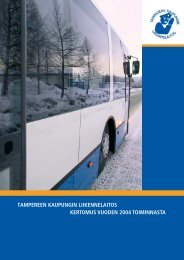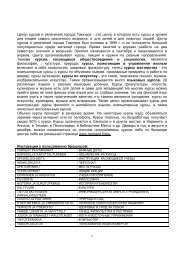- Tampere seizes creative economy
- Tampere seizes creative economy
- Tampere seizes creative economy
Create successful ePaper yourself
Turn your PDF publications into a flip-book with our unique Google optimized e-Paper software.
The games industry, open source and ambient<br />
intelligence all share the concept of <strong>creative</strong><br />
technology. <strong>Tampere</strong> therefore already<br />
has a strong grip on <strong>creative</strong> technologies that<br />
unlock future possibilities. But what does <strong>creative</strong><br />
technology actually mean?<br />
According to Ilkka Kaakkolammi from<br />
Technology Centre Hermia Ltd, any technology<br />
that combines elements in a new and <strong>creative</strong><br />
manner can in principle be defi ned as a <strong>creative</strong><br />
technology. In the ICT sector – most of all – <strong>creative</strong><br />
technologies and their applications are humanoriented<br />
as opposed to traditional development that<br />
has advanced in a more technology-pulled manner.<br />
Kaakkolammi directs both the <strong>Tampere</strong> Region<br />
Centre of Expertise Programme for Information and<br />
Communication Technology and Neogames.<br />
“The essential issue is how a technology serves<br />
its user and how applications of a technology ease<br />
people’s daily lives at home and in their place of<br />
work. When services and applications are expressly<br />
the driving forces, one abandons both technology<br />
push and thinking based on strict industrial<br />
boundaries,” Kaakkolammi says.<br />
The upshot is that the development of <strong>creative</strong><br />
technologies doesn’t concern the ICT sector alone;<br />
it helps build a competitive advantage extensively in<br />
many industries and in the entire urban region.<br />
“A <strong>creative</strong> application of technologies sets<br />
demands on the operating environment. <strong>Tampere</strong><br />
is an expanding city that continuously attracts new<br />
residents and hosts an extensive range of education<br />
and research, from technology to humanistic studies<br />
and the School of Art and Media. In addition,<br />
the city’s versatile business structure facilitates the<br />
exposure of new areas of application. This is where<br />
<strong>Tampere</strong>’s great opportunity lays.”<br />
Gameliness opens interaction<br />
Neogames has operated in <strong>Tampere</strong> for two years.<br />
It has brought together stakeholders from the<br />
Finnish games industry as well as from the media,<br />
content and technology industries. It has created<br />
both strong games industry expertise and a broader<br />
understanding of gameliness.<br />
“When speaking of <strong>creative</strong> technologies, I<br />
particularly emphasize the importance of gameliness<br />
as it also expands game features such as playability<br />
and use based on trial and error outside the actual<br />
games industry. In the interaction between a user and<br />
a technology, gameliness enables ways of action that<br />
humans fi nd natural,” Ilkka Kaakkolammi says.<br />
Possible areas of application range from digital<br />
media to industrial automation. Usability and<br />
communication on human terms are also in a key<br />
position in the research of ambient intelligence and<br />
ubiquitous technology. According to Kaakkolammi,<br />
usability expertise at the University of <strong>Tampere</strong> and<br />
the electronics research at <strong>Tampere</strong> University of<br />
Technology, for example, form a good foundation for<br />
the ambient intelligence development centre, which<br />
will launch its activities in the beginning of next<br />
year.<br />
“Today our environment is full of technology<br />
whose use we have to manage because technology<br />
doesn’t do anything by itself. By defi nition,<br />
ubiquitous technology is unnoticeable: humans can<br />
communicate with devices by means of speech for<br />
example, without awkward keyboards or monitors.<br />
With ambient intelligence, devices are also able to<br />
adapt to their environment and can partially operate<br />
themselves.”<br />
In practice, an application of ambient<br />
intelligence may mean an intelligent and remotely<br />
controlled home or offi ce environment, a smart<br />
garment that monitors and reacts to human body<br />
functions, a guide that is conscious of location or a<br />
product that can tell a consumer about itself from<br />
the retail shelf.<br />
“Creative solutions like these make it possible<br />
for a human to have genuine interaction with<br />
technology without having to concentrate on the use<br />
of devices and the management of technology. As<br />
such, a service produced by a technology need not<br />
be complicated as long as it genuinely reaches the<br />
citizen,” Kaakkolammi says.<br />
Global creativity in reach of <strong>Tampere</strong> residents<br />
Finding and creating possibilities for <strong>creative</strong><br />
applications requires a new way of thinking from<br />
companies, too. Globally and openly operating<br />
developer communities are an excellent example<br />
of a new kind of <strong>creative</strong> operation. Communities<br />
that break company and industry as well as state<br />
boundaries are richer than traditional closed<br />
innovation teams.<br />
“A unique innovation model and way of<br />
operation has evolved around open source.<br />
This model can also be utilized outside software<br />
production in content production, for example.<br />
Open source applications could, for instance,<br />
promote the proliferation of ambient intelligence<br />
solutions by bringing them within reach of everyone<br />
in an equal and easy manner,” says Director of COSS<br />
Petri Räsänen from Technology Centre Hermia Ltd.<br />
COSS is currently establishing its activities<br />
in <strong>Tampere</strong>. According to Räsänen, COSS has<br />
succeeded in creating an extensive network of<br />
companies and research institutes which has also<br />
led to COSS taking a distinct international role as a<br />
promoter of the use of open source and its business<br />
potential. There are currently several companies<br />
offering open source services in <strong>Tampere</strong>.<br />
“For example, in future the number of machine<br />
and equipment manufacturers utilizing OS solutions<br />
will increase and there will be a lot of demand<br />
for expertise related to open source. The initial<br />
enthusiasm created by Linux has already somewhat<br />
settled. However, there is now an increasingly clear<br />
awareness that business utilizing open source can be<br />
lasting and profi table.”<br />
Petri Räsänen points out that as new user<br />
applications emerge, new models for OS business<br />
will be found. Among others, a variety of application<br />
rental services have been established in recent<br />
years, based on the use of open source. According<br />
to Räsänen, potential user groups could be found<br />
particularly in government and services as well as the<br />
SME sector.<br />
“The task of open source, like that of other<br />
<strong>creative</strong> technologies, is to bring the information<br />
society seamlessly into people’s daily lives. Through<br />
open source, for example, <strong>Tampere</strong> residents are<br />
also able to be part of global creativity and, at<br />
best, be visible as individuals or companies in the<br />
international operating environment,” Räsänen<br />
envisions.<br />
<strong>Tampere</strong> Business • Science • Life 9


